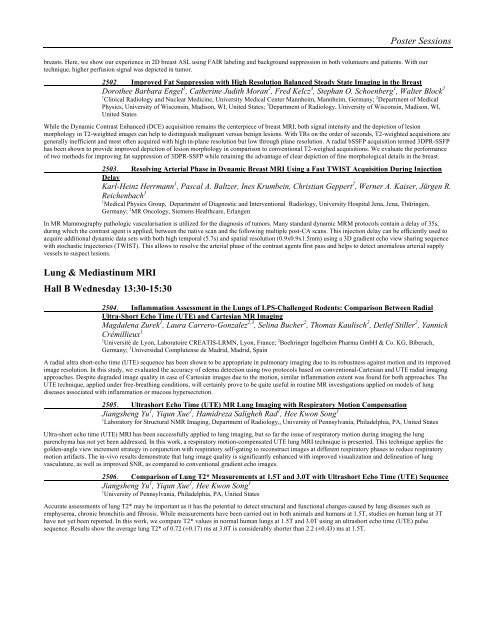TRADITIONAL POSTER - ismrm
TRADITIONAL POSTER - ismrm
TRADITIONAL POSTER - ismrm
Create successful ePaper yourself
Turn your PDF publications into a flip-book with our unique Google optimized e-Paper software.
Poster Sessions<br />
breasts. Here, we show our experience in 2D breast ASL using FAIR labeling and background suppression in both volunteers and patients. With our<br />
technique, higher perfusion signal was depicted in tumor.<br />
2502. Improved Fat Suppression with High Resolution Balanced Steady State Imaging in the Breast<br />
Dorothee Barbara Engel 1 , Catherine Judith Moran 2 , Fred Kelcz 3 , Stephan O. Schoenberg 1 , Walter Block 2<br />
1 Clinical Radiology and Nuclear Medicine, University Medical Center Mannheim, Mannheim, Germany; 2 Department of Medical<br />
Physics, University of Wisconsin, Madison, WI, United States; 3 Department of Radiology, University of Wisconsin, Madison, WI,<br />
United States<br />
While the Dynamic Contrast Enhanced (DCE) acquisition remains the centerpiece of breast MRI, both signal intensity and the depiction of lesion<br />
morphology in T2-weighted images can help to distinguish malignant versus benign lesions. With TRs on the order of seconds, T2-weighted acquisitions are<br />
generally inefficient and most often acquired with high in-plane resolution but low through plane resolution. A radial bSSFP acquisition termed 3DPR-SSFP<br />
has been shown to provide improved depiction of lesion morphology in comparison to conventional T2-weighed acquisitions. We evaluate the performance<br />
of two methods for improving fat suppression of 3DPR-SSFP while retaining the advantage of clear depiction of fine morphological details in the breast.<br />
2503. Resolving Arterial Phase in Dynamic Breast MRI Using a Fast TWIST Acquisition During Injection<br />
Delay<br />
Karl-Heinz Herrmann 1 , Pascal A. Baltzer, Ines Krumbein, Christian Geppert 2 , Werner A. Kaiser, Jürgen R.<br />
Reichenbach 1<br />
1 Medical Physics Group, Department of Diagnostic and Interventional Radiology, University Hospital Jena, Jena, Thüringen,<br />
Germany; 2 MR Oncology, Siemens Healthcare, Erlangen<br />
In MR Mammography pathologic vascularisation is utilized for the diagnosis of tumors. Many standard dynamic MRM protocols contain a delay of 35s,<br />
during which the contrast agent is applied, between the native scan and the following multiple post-CA scans. This injection delay can be efficiently used to<br />
acquire additional dynamic data sets with both high temporal (5.7s) and spatial resolution (0.9x0.9x1.5mm) using a 3D gradient echo view sharing sequence<br />
with stochastic trajectories (TWIST). This allows to resolve the arterial phase of the contrast agents first pass and helps to detect anomalous arterial supply<br />
vessels to suspect lesions.<br />
Lung & Mediastinum MRI<br />
Hall B Wednesday 13:30-15:30<br />
2504. Inflammation Assessment in the Lungs of LPS-Challenged Rodents: Comparison Between Radial<br />
Ultra-Short Echo Time (UTE) and Cartesian MR Imaging<br />
Magdalena Zurek 1 , Laura Carrero-Gonzalez 2,3 , Selina Bucher 2 , Thomas Kaulisch 2 , Detlef Stiller 2 , Yannick<br />
Crémillieux 1<br />
1 Université de Lyon, Laboratoire CREATIS-LRMN, Lyon, France; 2 Boehringer Ingelheim Pharma GmbH & Co. KG, Biberach,<br />
Germany; 3 Universidad Complutense de Madrid, Madrid, Spain<br />
A radial ultra short-echo time (UTE) sequence has been shown to be appropriate in pulmonary imaging due to its robustness against motion and its improved<br />
image resolution. In this study, we evaluated the accuracy of edema detection using two protocols based on conventional-Cartesian and UTE radial imaging<br />
approaches. Despite degraded image quality in case of Cartesian images due to the motion, similar inflammation extent was found for both approaches. The<br />
UTE technique, applied under free-breathing conditions, will certainly prove to be quite useful in routine MR investigations applied on models of lung<br />
diseases associated with inflammation or mucous hypersecretion.<br />
2505. Ultrashort Echo Time (UTE) MR Lung Imaging with Respiratory Motion Compensation<br />
Jiangsheng Yu 1 , Yiqun Xue 1 , Hamidreza Saligheh Rad 1 , Hee Kwon Song 1<br />
1 Laboratory for Structural NMR Imaging, Department of Radiology,, University of Pennsylvania, Philadelphia, PA, United States<br />
Ultra-short echo time (UTE) MRI has been successfully applied to lung imaging, but so far the issue of respiratory motion during imaging the lung<br />
parenchyma has not yet been addressed. In this work, a respiratory motion-compensated UTE lung MRI technique is presented. This technique applies the<br />
golden-angle view increment strategy in conjunction with respiratory self-gating to reconstruct images at different respiratory phases to reduce respiratory<br />
motion artifacts. The in-vivo results demonstrate that lung image quality is significantly enhanced with improved visualization and delineation of lung<br />
vasculature, as well as improved SNR, as compared to conventional gradient echo images.<br />
2506. Comparison of Lung T2* Measurements at 1.5T and 3.0T with Ultrashort Echo Time (UTE) Sequence<br />
Jiangsheng Yu 1 , Yiqun Xue 1 , Hee Kwon Song 1<br />
1 University of Pennsylvania, Philadelphia, PA, United States<br />
Accurate assessments of lung T2* may be important as it has the potential to detect structural and functional changes caused by lung diseases such as<br />
emphysema, chronic bronchitis and fibrosis. While measurements have been carried out in both animals and humans at 1.5T, studies on human lung at 3T<br />
have not yet been reported. In this work, we compare T2* values in normal human lungs at 1.5T and 3.0T using an ultrashort echo time (UTE) pulse<br />
sequence. Results show the average lung T2* of 0.72 (±0.17) ms at 3.0T is considerably shorter than 2.2 (±0.43) ms at 1.5T.















